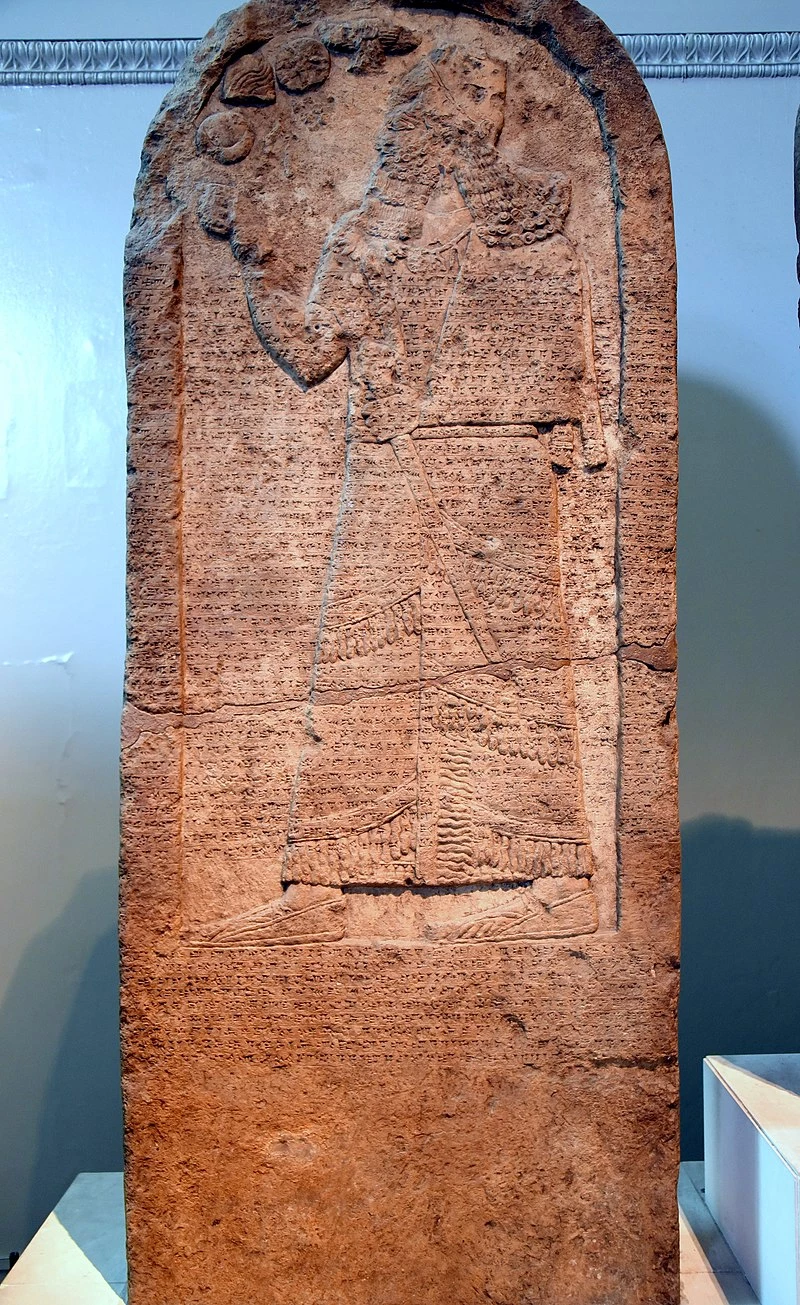
Shalmaneser III praying in front of divine symbols. The cuneiform inscription is a text of a version of the King’s annals and narrates his campaign in chronological order, concluding with a description of the battle of Qarqar in 853 BC against a large Syrian coalition led by the king of Aram-Damascus. The artifact dates to the Neo-Assyrian Period. It was found in Kurkh, Diyarbakir, modern-day Turkey. It’s present location is the British Museum.
One version of the royal annals of Shalmaneser III (858-824 BC), king of Assyria, is engraved on a large stone stele found at Kurkh in 1861, and commonly referred to as the Kurkh Monolith. See A. K. Grayson, Assyrian Rulers of the First Millennium BC II (858–745) (RIMA 3; Toronto: University of Toronto Press, 1996): 11-24.
The stone narrates the king’s military campaigns in their chronological order from 859 to 853 BC. The text ends abruptly after a description of the Battle of Qarqar in 853 BC so the monument was probably carved in 853 or in 852 BC. The text was engraved in such a hurry that there are numerous scribal errors throughout the composition, including major spelling errors at the very end.
The royal monument has generated a tremendous amount of interest since its discovery in the 19th century because it provides the earliest known reference to the Northern Kingdom of Ya’ohsharal. Column 2, lines 78-102 lists three major players in the anti-Assyrian coalition who fought against Shalmaneser III at the Battle of Qarqar in 853 BC: Adad-idri (Hadadezer) of Aram-Damascus; Irhuleni of Hamath; and Ahabbu (a-ha-ab-bu) of Sir-‘ila (col. 2, lines 91-92). The conventional interpretation of virtually all European and American scholars is that the third king is the biblical king “Akhab (Ahab) of the land of Israel”.
This popular interpretation is wrong and should be rejected for the following reason. The biblical king Akhab reigned 22 years from 922 to 901 BC according to the bible’s internal chronology. The Battle of Qarqar took place 48 years AFTER Akhab’s death. The king of the Northern Kingdom at the time of the Battle of Qarqar was not Akhab. It was Ya’oh-akhaz (863-847 BC). George Smith rejected the identification of Akhab with the a-ha-ab-bu of this inscription for this very reason:
“Under these circumstances I have given up the identification of the Ahab who assisted Ben-hadad at the battle of Qarqar, B.C. 854, with the Ahab, king of Israel, who died, I believe, forty-five years earlier (George Smith, Assyrian Eponym Canon [1875], pages 188-189)”.
But European scholars nowadays believe the bible’s internal chronology is wrong, so they fiddle and tinker with the biblical chronological figures to reduce the chronology by half a century in order to move the reign of Akhab forward in time so that he is alive in 853 BC to fit their interpretation. That doesn’t work with me. The bible is not wrong here. The common interpretation that says “a-ha-ab-bu” is the same person as Akhab is wrong.
The Assyrian scribe was in a rush when he made this inscription. The many mistakes he made everywhere else in this text leads one to naturally conclude that he simply made a mistake in the spelling of the Ya’ohsharalay king’s name. He was supposed to write “Ya’oh-akhaz” but he omitted the diminutive theophoric element YW (= YA’OH) and he confused the second element “a-kha-z” with being “a-ha-ab-bu.”
This king is not mentioned in any of the other versions of the annals of Shalmaneser III which retell the Battle of Qarqar. It suggests that he was not actually present at the battle in the first place. He is only mentioned presumably because Aram-Damascus, the leader of the anti-Assyrian coalition, viewed the king of northern Ya’ohsharal as his subordinate and put him down as a member of his coalition. Yet the fact of the matter is that the Northern Kingdom of Ya’ohsharal was neither a subordinate of Aram-Damascus, nor an ally of theirs at this time in 853 BC.
The Assyrian scribe also screwed up the name of the biblical king’s country and this is something every scholar is in agreement that he did. There was never any country in southern Syria called “Sir-‘ila.” This is just a botched attempt to write SHAR-AL (“prince of God”) without the diminutive theorphoric element Y (= YA’OH).
The name of God’s people is a vocative expression, YA’OH-SHAR-AL, which means: “Oh YA’OH, a prince of God”.
His name is YA’OH
Always has been. Always will be.
